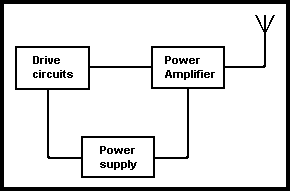
Radio transmitters, irrespective of their application, must:
A transmitter therefore consists of a 'power amplifier' (PA) to provide the necessary output power which is preceded by low power drive circuits to generate the RF input to the PA at the required frequencies. The drive circuits may well include the means by which modulation of the transmitter is achieved (see Fig 4.1.)

Fig 4.1. Block diagram of a transmitter
An amateur transmitter is required to operate on any in a number of bands. As 'netting' (that is, stations in communication operating on the same frequency) is almost universal in amateur radio, it is necessary to be able to set the transmitter frequency to any particular value.
A variable frequency oscillator (VFO) is therefore the basic RF source for the drive circuits.